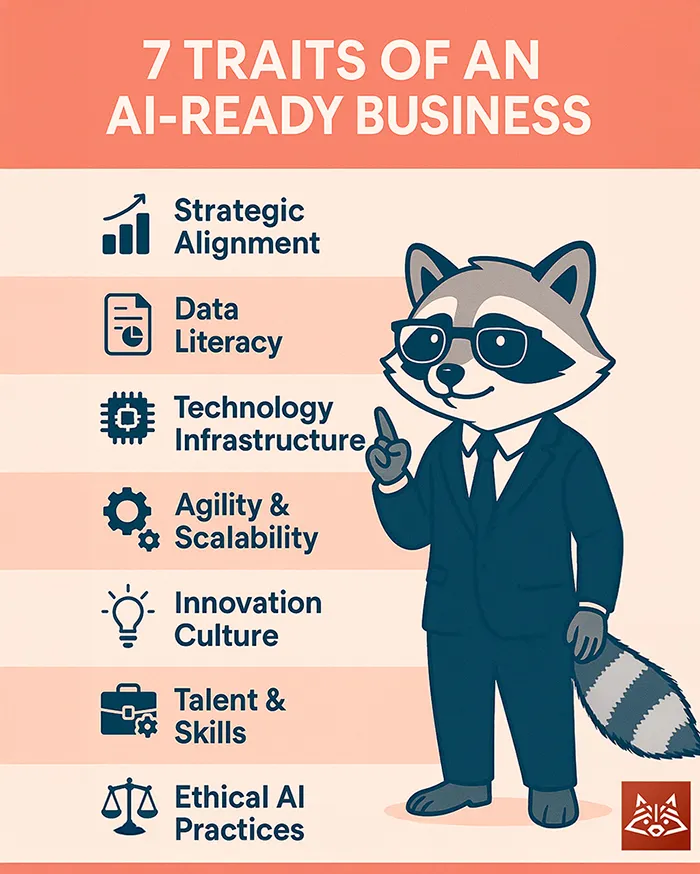Fast-Forward Facts
- 82 % of small businesses now believe adopting AI is “essential to stay competitive,” yet only 25 % have operationalized it
- Large-enterprise AI adoption has surged to 78 % of business functions, with 71 % already using Gen-AI—proof that the gap is widening daily
- When AI initiatives mature, more than half of companies see measurable revenue lifts—up to 70 % of units in strategy & finance report gains
- Gartner still pegs poor data quality at a $12.9 M annual drag on the average organisation
The story these numbers tell is simple: the winners are already preparing; the rest are paying an invisible tax. Over the past five years I’ve guided family-run manufacturers, fast-growing SaaS firms, and international companies through AI transformation. The patterns are unmistakable—seven systemic traits separate the frontrunners from the nearly-theres.
Below is the distilled blueprint I use inside Neoground’s strategy labs. Treat it as a mirror: where you’re strong, double down; where you’re weak, start architecting change.
Trait 1 — Systems Thinking as Default
AI is not a feature—it’s an organ. It only thrives inside a healthy body.
High-performing firms map flows, not silos. They model the entire value chain (data → decision → delivery) long before they buy a single licence. This architectural view lets us insert AI modules—prediction APIs, copilots, autonomous agents—without ripping up the floorboards later.
Quick audit: Can your team visualize your core processes on one page? If not, start there.
Trait 2 — Digital Fluency from C-Suite to Shop Floor
McKinsey’s latest survey found that CEO oversight of AI governance correlates strongest with EBIT impact. Translation: leadership must understand and speak AI. Yet fluency must cascade—operators, marketers, even finance clerks should know how to co-create with a copilot.
Tip: Run monthly “Prompt-Gym” sessions—short, role-specific drills where staff iterate real prompts, measure accuracy, and share best practices. We’ve installed this ritual in three SMBs; all reported >20 % time savings within a quarter.
Trait 3 — Data Hygiene & Governance
AI amplifies whatever you feed it. Gartner’s $12.9 M data-quality tax is the silent killer of ROI. The AI-ready business stores context-rich, well-labelled data with lineage, access policies, and feedback loops.
Blueprint:
- Inventory every dataset (owner, purpose, freshness).
- Score each on completeness, accuracy, and legal compliance.
- Automate fixes—validation rules, real-time anomaly alerts.
The upside isn’t just model accuracy; it’s trust—legal, customer, and boardroom-level.
Trait 4 — Modular, API-First Processes
Rigid ERP monoliths suffocated many early AI pilots. Today’s winners expose granular services (pricing, inventory, customer profile) via APIs, making it trivial to bolt on a predictive model or Gen-AI agent. In my practice we call this “business as Lego.” The pieces snap; they don’t shatter.
Trait 5 — Culture of Experimentation
AI thrives on iteration. Reimagine Main Street’s survey shows 51 % of SMBs are exploring but not yet shipping AI—often because pilots get stuck waiting for perfect conditions. High-growth firms run sandbox sprints: two-week cycles where tiny cross-functional squads test a single hypothesis, measure, then decide to scale or scrap.
Metric to watch: Time-to-first-insight (TTI). If your POCs take months, re-engineer your decision gates.
Trait 6 — Human-AI Symbiosis
Verizon’s 2025 State of Small Business Survey shows 38 % of SMBs already use AI for marketing, talent, or service—but many still fear displacement. Leaders who pair humans with AI (think: analyst ↔ insight-copilot) rather than replace them unlock compounding productivity and morale.
Practical step: Draft “AI role charters” that explicitly state how each role uses automation, freeing staff for creative, relational, or strategic work.
Trait 7 — Strategic Foresight & Governance
Markets, regulations, and models evolve weekly. My top-performing clients run quarterly AI Scenario Rooms—mini-war-games where executives model best-case, likely, and black-swan AI futures. Governance frameworks, ethics boards, and KPI dashboards emerge from these sessions, not from vendor slide decks.
The Architect’s Perspective
AI readiness looks less like installing software and more like city planning: zoning (data domains), utilities (APIs), regulations (governance), and public spaces (collaboration culture). As a polymath, I draw equally from network engineering, cognitive science, and policy design. That cross-domain lens lets us see second-order effects—how a chatbot reshapes brand voice, or how an optimisation model alters supply-chain resilience.
Clients say this “systems fluency” is why we deliver transformation without the typical bloodshed. My personal KPI: the moment a board stops asking “Can we use AI?” and starts asking “Where else can we compose intelligence into our architecture?”
TL;DR — Your 7-Trait Scorecard
- Systems Thinking
- Digital Fluency
- Data Hygiene & Governance
- Modular, API-First Processes
- Culture of Experimentation
- Human-AI Symbiosis
- Strategic Foresight & Governance
How many boxes did you tick confidently?
Here's also an infographic distilling more insights:

Next Moves
- Download our free Business Playbook: Integrating AI and Digital Strategies ebook and deepen your knowledge.
- Book a Strategy Mirror Session—a 60-minute deep-dive where I map your current architecture and highlight high-ROI AI openings.
Ready to architect your AI-ready future?
This article was created by us with the support of Artificial Intelligence (GPT-o3 / GPT-4o).
All images are AI-generated by us using Sora.




Noch keine Kommentare
Kommentar hinzufügen